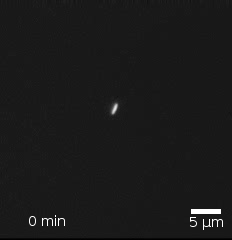9.03 Growth and decay
We have analysed the features of exponential functions and their graphs. We will now use this knowledge as we investigate physical situations that can be modelled by exponential functions.
Exponential growth
In the process of cell division doubling each day, the number of cells present increased from $1$1 to $2$2 to $4$4 to $8$8, and would continue to reach $16,32,64,\ldots$16,32,64,…

Exponential growth exhibited in a colony of E. coli bacteria. Source: Wikimedia commons
The greater the quantity of cells, the faster the number grows.
Another way to describe this is to say that the quantity is increasing at a rate that is proportional to the amount present. Any time a quantity grows in this way, it is increasing at an exponential rate. This kind of increase is called exponential growth.
Exponential growth often appears in population models, and we will use a simple model to explore a historical case.
In 1859 a single English settler of Australia released European rabbits onto his property to hunt them for sport. A pair of rabbits is capable of producing two or more offspring every $30$30 days, so in effect the population of rabbits in a particular area doubles every month. If only a single pair of rabbits released by the settler survived and bred like this, then the population would change over the first $7$7 months as shown in the table below.
| Month | $1$1 | $2$2 | $3$3 | $4$4 | $5$5 | $6$6 | $7$7 |
|---|---|---|---|---|---|---|---|
| Rabbits | $2$2 | $4$4 | $8$8 | $16$16 | $32$32 | $64$64 | $128$128 |
Under this model, we can see that the number of rabbits isn't just increasing, it is increasing at a faster and faster rate. The more rabbits there are, the faster they grow in number. That is, the number of rabbits is increasing at an exponential rate. If you continue the pattern you will see for yourself how Australia was overwhelmed with millions and millions of rabbits within a decade!
Looking deeper into the numbers in the model, we can see that starting with $2$2 rabbits and doubling each time means the rabbit population is always a power of $2$2. So we could model this with the exponential function $R=2^x$R=2x, where $R$R is the number of rabbits after $x$x months. Here is a graph of this function:

Exponential decay
Similarly to exponential growth, any time a quantity is decreasing at a rate that is proportional to the current amount, the quantity is decreasing at an exponential rate. A rough paraphrase would be "the smaller it gets, the slower it decays". This kind of decrease is called exponential decay.
Radioactive substances lose mass and release energy over time in a process modelled by exponential decay. An example is Ruthenium-106, a waste product of nuclear power. Every year around half of the substance releases its energy (we say it has a half-life of one year) while the other half remains toxic. This means that if we started with $1$1 gram of Ruthenium-106, after $1$1 year there would be $0.5$0.5 grams ($\frac{1}{2}$12 of a gram) left, after $2$2 years there would be $0.25$0.25 grams ($\frac{1}{2}$12 of a $\frac{1}{2}$12 of a gram) left, and so on. The mass of Ruthenium-106 over the first $6$6 years is shown in the table below.
| Years | $0$0 | $1$1 | $2$2 | $3$3 | $4$4 | $5$5 | $6$6 |
|---|---|---|---|---|---|---|---|
| Mass (g) | $1$1 | $\frac{1}{2}$12 | $\frac{1}{4}$14 | $\frac{1}{8}$18 | $\frac{1}{16}$116 | $\frac{1}{32}$132 | $\frac{1}{64}$164 |
Under this model, we can see that the mass of the substance is decreasing, but at a slower and slower rate. The less mass there is, the slower it loses mass. That is, mass of the substance is decaying at an exponential rate.
The mass of the substance is halving each year, so the denominator of the fraction is always a power of $2$2. We can model this situation with the exponential function $M=\frac{1}{2^x}=2^{-x}$M=12x=2−x, where $M$M is the mass of the isotope and $x$x is the number of years that have passed. Here is a graph of this function:

Notice that the $y$y-intercept of the curve represents the initial amount of Ruthenium-106. No matter how much time passes (that is, no matter how large $x$x gets) the mass of the substance never quite reaches zero. This is a feature of all the exponentials we will explore: their value is always positive. And this is a major reason why nuclear energy is so carefully considered as an energy source, because radioactive substances don't ever completely break down.
Practice questions
Question 1
In a laboratory, the number of bacteria in a petri dish is recorded, and the bacteria are found to triple each hour.
Complete the table of values.
Number of hours passed ($x$x) $0$0 $1$1 $2$2 $3$3 $4$4 Number of bacteria ($y$y) $1$1 $\editable{}$ $9$9 $\editable{}$ $\editable{}$ If $y$y represents the number of bacteria at time $x$x, which of the following equations could model the situation?
$y=3^x$y=3x
A$y=x^3$y=x3
B$y=3^{-x}$y=3−x
C$y=x^{-3}$y=x−3
DAt this rate, how many bacteria will be present in the petri dish after $12$12 hours?
Question 2
A sample contains $1$1 gram of Ruthenium-106, which has a half-life of one year.
Write a function, $A$A, to represent the amount of the sample remaining after $n$n years.
Between which two years does Ruthenium-106 lose the most mass?
Between years $3$3 and $4$4.
ABetween years $5$5 and $6$6.
BBetween years $6$6 and $7$7.
CBetween years $10$10 and $11$11.
D